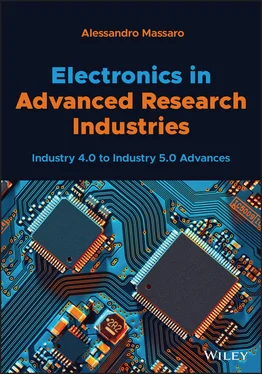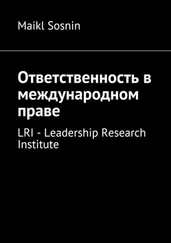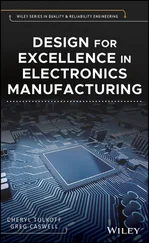The innovative technology to be implemented in industrial sectors is listed in Table 1.10(Horizon 2020 topics).
Table 1.10 Industrial sectors and advanced application fields.
| Industrial sectors |
Application fields |
| Processes and industrial installationsManufacturing and advanced transformation |
Methodologies and standards for the machine and system design in complex manufacturingTools for design and implementation of high‐quality productsAutomation and integration of complex manufacturing systems for real‐time productionsInformation technologies for the integration of supply chain and decision‐making processControl technologies, predictive, maintenance, diagnosis of manufacturing systems improving efficiency and life cyclesTechnologies and software solutions for real manufacturing and logisticsMechatronic components for efficiency production and productsNew machines and eco‐sustainable systems to optimize energy efficiency and the environmental impact of production systemsInnovative materials for components, machines, and systemsIntelligent adaptive production systems |
| Mobility and transport |
Road/sea/rail transport technologies and solutions to reduce environmental impact, optimize safety, quality, performance, and energy efficiencyEnvironmentally transport technologies for sustainabilityIntelligent transport systemsIntelligent inspection systemsSmart road technologies |
| Aerospace and aeronautics |
New materials and production processesPredictive maintenance for aircraftEco‐friendly enginesTechnologies for reduction of environmental impactSimulation methodologies for integrated design in the aeronautical fieldTechnologies for autonomous systemsAdvanced air traffic managementIntegrated technologies for securitySpace transport technologiesSpace advance operational technologiesRemote sensing and data navigation technologies |
| Biotechnologies |
Genomics, meta‐genomics, proteomics, and metabolomicsTechnologies for pharmaceutical chemistryBiomarkersBiomolecular productionTechnologies and methods for molecular imagingMinimally invasive technologiesTechnologies for advanced and precision therapiesTissue engineeringBioinformaticsTechnologies related to industrial processes based on biotechnology (chemistry, health, agri‐food, etc.) |
| Chemistry |
Technologies for reducing environmental impact (technologies for recovery of polymeric materials, substitution of high‐risk substances, etc.)Technologies from renewable resources (biorefinery processes, biochemical technologies, raw materials for alternatives energy, etc.)Nanomaterials for packaging and foodNanomaterials for chemical processes |
| Energy and environment |
Transport technologies and energy storageEnergy production technologies and advanced materialsTechnologies for the use of biomass and biofuelTechnologies for solar energy enhancementTechnologies for energy efficiencySmart grid, smart metering, and smart energyTechnologies for the reduction of emissionsTechnologies for energy intelligent networksRenewable energiesTechnologies for environmental protectionEnergy efficiency and sustainability of buildingsSafety of the built environment |
| Microelectronics and semiconductors |
Integration of electronic systems on siliconPhotovoltaic applicationsAlternative materials to siliconHeterogeneous integrationsManufacturing techniques and design methodsSensor technologies integrated on siliconSilicon photonics |
| Informatic and telecommunications |
New information technologies (tools and technologies to manage processes, big data storage, human machine interfaces, etc.)Application platforms of information technologiesNew network and service architecturesMobile networks and servicesTechnologies for broadband networksTechnologies for information mobilityTechnologies for network securityAdvanced interfaces and robotsTechnologies for systems innovationOptical and wireless communicationTechnologies related to microelectronics, nanoelectronics, and photonics |
| Advanced materials |
Technologies related to functional, multifunctional, and structural materials (self‐repairing materials, self‐adaptive materials, biocompatible materials)Development and transformation of materials (dynamic production)Techniques and new and innovative systems in assembly, self‐assembly, separation, and disassemblyTechnologies and materials for low production of carbon emissionsTechnologies related to materials for creative industriesMetrology, characterization, standardization, and quality controlTechnologies related to optimization of the use of materials |
| Nanotechnologies |
Nanomaterials, nanodevices, and next generation nanosystemsScientific tools and platforms for evaluation and risk management throughout the lifecycle of nanomaterials and of nanosystemsNew production of nanomaterials in advanced devices as innovative productsSynthesis and fabrication of nanomaterialsDevelopment support technologies for nanomaterial characterization and productionModeling and design of devices in nanoscale |
The enabling technologies of the application fields in the Industry 5.0 scenario are:
Nanotechnologies.
Micro‐ and nanoelectronics.
Biotechnologies.
Advanced functionalized materials.
Photonics.
Advanced materials.
Advanced production technologies.
AI and big data systems.
Biomaterials.
Virtual reality and AR.
Lab‐on‐chip.
Advanced electromagnetic sensors and compatibility.
Advanced high temperature materials.
Advanced software and hardware production technologies.
Diagnostic inspection technologies.
Innovative systems for diagnostics.
1 1 Vaidya, S., Prashant, A., and Bhosle, S. (2018). Industry 4.0 – a glimpse. Procedia Manufacturing 20 (1): 233–238.
2 2 Moon, S.H. (2018). Industry 4.0 for advanced manufacturing and its implementation. Eurasian Journal of Analytical Chemistry 13 (6): 491–497.
3 3 Ruppert, T., Jaskó, S., Holczinger, T., and Abonyi, J. (2018). Enabling technologies for operator 4.0: a survey. Applied Sciences 8 (1650): 1–19.
4 4 Lampropoulos, G., Siekas, K., and Anastasiadis, T. (2019). Internet of Things in the context of industry 4.0: an overview. International Journal of Entrepreneurial Knowledge 7 (1): 4–19.
5 5 Novak‐Marcincin, J., Barna, J., Janak, M., and Novakova‐Marcincinova, L. (2013). Augmented reality aided manufacturing. Procedia Computer Science 25 (1): 23–31.
6 6 Segovia, D., Mendoza, M., Mendoza, E., and González, E. (2015). Augmented reality as a tool for production and quality monitoring. Procedia Computer Science 75 (1): 291–300.
7 7 Bottani, E. and Vignali, G. (2019). Augmented reality technology in the manufacturing industry: a review of the last decade. IISE Transactions 51 (3): 284–310.
8 8 Cioffi, R., Travaglioni, M., Piscitelli, G. et al. (2020). Artificial intelligence and machine learning applications in smart production: progress, trends, and directions. Sustainability 12 (492): 1–26.
9 9 Lee, W.J., Wu, H., Yun, H. et al. (2019). Predictive maintenance of machine tool systems using artificial intelligence techniques applied to machine condition data. Procedia CIRP 80 (1): 506–511.
10 10 Pandarakone, S.E., Mizuno, Y., and Nakamura, H. (2019). A comparative study between machine learning algorithm and artificial intelligence neural network in detecting minor bearing fault of induction motors. Energies 12 (2105): 1–14.
11 11 Pérez, L., Rodríguez, Í., Rodríguez, N. et al. (2016). Robot guidance using machine vision techniques in industrial environments: a comparative review. Sensors 16 (335): 1–26.
Читать дальше












